- Home
- Sponsors
- Forums
- Members ˅
- Resources ˅
- Files
- FAQ ˅
- Jobs
-
Webinars ˅
- Upcoming Food Safety Fridays
- Upcoming Hot Topics from Sponsors
- Recorded Food Safety Fridays
- Recorded Food Safety Essentials
- Recorded Hot Topics from Sponsors
- Food Safety Live 2013
- Food Safety Live 2014
- Food Safety Live 2015
- Food Safety Live 2016
- Food Safety Live 2017
- Food Safety Live 2018
- Food Safety Live 2019
- Food Safety Live 2020
- Food Safety Live 2021
- Training ˅
- Links
- Store ˅
- More
Advertisement
Featured Implementation Packages
-
ISO 22000 Food Safety Management System - Food Manufacturers Edition - 2018
This is an ideal package for Food Manufacturers looking to meet International Fo... more
-
IFS Food Safety and Quality Management System - Version 7
The IFSQN IFS Food Safety and Quality Management System Package is an ideal pack... more
SQF from Scratch: 2.1 Management Commitment, 2.1.1 Food Safety Policy
Jan 10 2020 07:02 PM | FurFarmandFork
SQF 2.1 Management Commitment 2.1.1 Food Safety Policy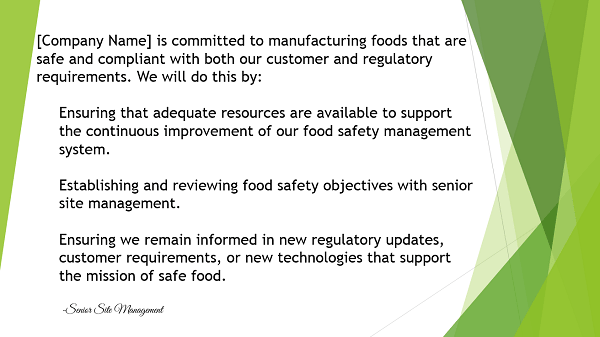
Remember, the goal is not “Audit ready 365”, it’s to know that our facility embraces globally recognized best practices to maintain food safety. Because of this, as we dive into each element, we must always remember the quality management system golden rule: Never make systems to “pass audits”. Make systems that work for your company that help it make safer/higher quality products more efficiently.
2.1 Management Commitment
Management commitment is the pre-requisite to company culture. Whether talking about safety culture, lean culture, continuous improvement culture, anti-discriminatory culture, ethical business culture, or food safety culture, company direction and leadership begins with those holding the purse strings at the top.
The fact that this is our FIRST element is not a mistake, it’s an acknowledgement that this process will have no legs if it is not supported by those in control of the business. SQF has taken the same approach that successful safety, lean, and corporate responsibility initiatives have, wherein you begin with missions and core values that provide a compass for company priorities, especially when you get stuck back in the day-to-day.
The code:
2.1 Management Commitment
2.1.1 Food Safety Policy (Mandatory)
2.1.1.1 Senior site management shall prepare and implement a policy statement that outlines as a minimum the:
i. The site's commitment to supply safe food;
ii. Methods used to comply with its customer and regulatory requirements and continually improve its food safety management system; and
iii. The site's commitment to establish and review food safety objectives.
2.1.1.2 The policy statement shall be:
i. Signed by senior site management;
ii. Made available in language understood by all staff;
iii. Displayed in a prominent position; and
iv. Effectively communicated to all staff
What’s the point? How is this making our product safer?
Food safety procedure is what we tend to think of when we consider GFSI certification, a.k.a. all the stuff we should/need to get done. But each element of the code begins with “policy”; we’re asked to define our values as a company, from which our actions and priorities will follow.
SQF doesn’t begin the code with with any specific rule or task, but by asking us as an organization to establish food safety as part of our company’s core values. Not just a series of forms or tasks to be completed, but a wholistic view that when we strategize and determine the direction our business will take, food safety is going to be just as much a part of that discussion as finance.
Accepting and committing to food safety as a senior management value empowers departments, teams, and individuals to also treat food safety as a priority in their work. It shows all levels of the organization that GFSI certification isn’t just a pile of requirements, but a representation of what leadership is going to look for when they identify high performers and reliable employees.
What am I being asked to do?
You need a sort of company values/mission statement style document, you need the top representatives at your company site to review and sign it, and it needs to be posted and visible to your workforce.
Ideally, take some time to work with management to make something unique to your company. Maybe it’s formed on customer issues in the past, or ties into your existing mission statement. At the end of the day, there are some specifics that you, the SQF practitioner, are going to want to stick in there. Our standard approach is going to be taking the code line by line and making sure that language is represented or even mirrored in our documentation.
Whenever SQF asks for a policy, you have two objectives. First, that the people who are leaders supporting the policy know and embrace it. Second, that you have included language clear enough that you can defend your policy to an auditor who may just be using the code to “tick the box”. Below is an example policy that simply parrots the actual code. This will work very well in an audit but is not tailored specific to any particular company. Ideally your policy will reference your specific products and challenges.
I. Policy
a. [Company Name] is committed to manufacturing foods that are safe and compliant with both our customer and regulatory requirements. We will do this by:
i. Ensuring that adequate resources are available to support the continuous improvement of our food safety management system.
ii. Establishing and reviewing food safety objectives with senior site management.
iii. Ensuring we remain informed in new regulatory updates, customer requirements, or new technologies that support the mission of safe food.
To make this available, stick it into your SOP’s and maybe regular training. But it’s common (therefore expected by auditors) that it’s incorporated into signage. A simple way to do this is to build a sign in Microsoft PowerPoint (which will create a vector image that will scale indefinitely with size and still print well), then use a local print shop to print a laminated sign (or order a fancier sign if you prefer).
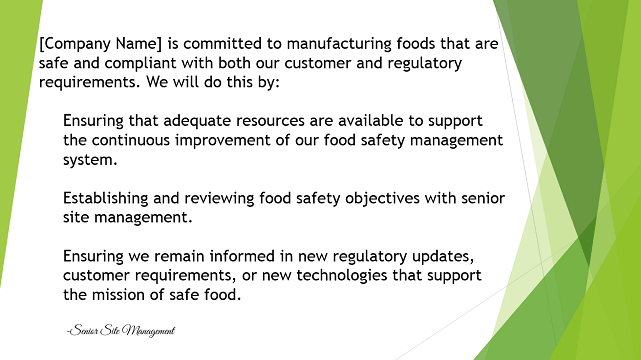
Get that somewhere visible for all staff and you’re good to go!
How will this be audited?
Auditors are going to look at the document, how it’s made available to your staff, and whether anyone on your production floor knows what it is and where to find it. If they talk to several new temps who say, “no idea, I was just put out on the line”, that’s going to be a potential issue. For the most part, effective implementation and evidence of management commitment is going to be more covered by 2.1.2 Management Responsibility.
Typically points of contention will be when auditors disagree with the language in your policy, that’s fine as long as you can defend it! Make sure your policy obviously covers all the components identified in the code, and don’t worry about an auditor who wants to go after semantics. It isn’t law if an auditor claims “you didn’t say continuously improve” when your statement says, “our system is going to be flexible and achieve the highest quality possible to support our customers”. OF COURSE that means you’re going to review and improve it! Back it up with evidence that you actually do and feel free to let the auditor grouse about how they would have written something different.
It’s not their company, their liability, its yours. And the opinion of a single audit should not change the way your entire facility communicates its food safety values from the top the other 364 days of the year. Modifying your mission statement based on auditor preference violates our golden rule.
Author Biography:

Austin Bouck is a food safety consultant and manufacturing supervisor in Oregon, USA. You can find more food safety resources and discussion on his website, Fur, Farm, and Fork, as well as contact information for consulting services.

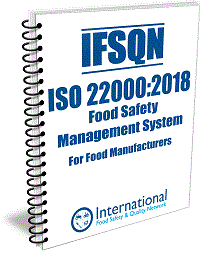
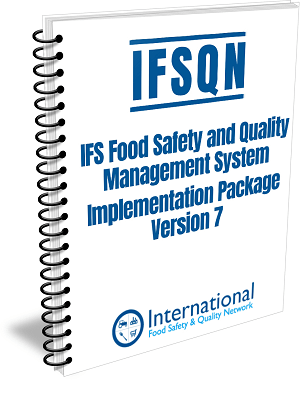

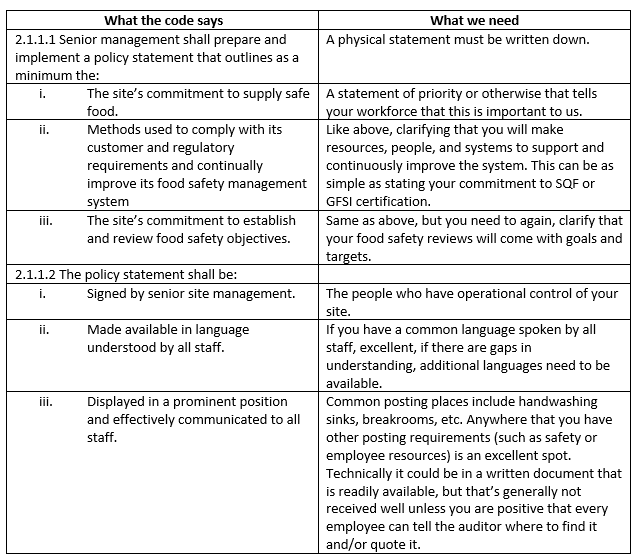





9 Comments
Thank you for this. We've been SQF certified for a number of years, but recently we hired a new plant manager who hasn't work in the food industry for many years. This will help introduce him to SQF in an informative manner. (So much of this is second nature to me, I was worried about starting at the beginning).
I admire the intent. It's going to be a long term project if fully inclusive.
The SQF Official Guidance material is also quite helpful albeit somewhat more authoritarian.
Specific examples certainly assist.
New to SQF and thankful to those willing to help make it easier to understand. Specific examples are a tremendous asset!
Thank you!
Austin,
This is great stuff and find it helpful. I like the way you lay out the information, break it down, and give some real world examples.
Thanks
Thank you Austin,
I wish this was here when I was building our SQF program. The examples are great help.
How often will the articles of the other elements be uploaded?
Thanks again,
Hi mpins,
These articles should come out around monthly, but final timing will be determined by the IFSQN team. Needless to say they'll keep coming!
It is much easier for us to publish an article than it is to write it, clearly a huge amount of work goes into them. One a month would be great. How many would it take to cover the standard?
Thankyou for posting a very valuable resource. I am new to this forum but have quickly realized the significant benefits of engagement with industry peers. Food Safety Policy goes to the heart of the organization's ethos and culture, however it's only as good as the lowest common denominator and is totally ineffective without a robust knowledge sharing and internal communication process.
Thank You for all the effort you put into the articles, a little clarity goes a long way when trying to decipher the SQF code and implementing the requirements. Much appreciated